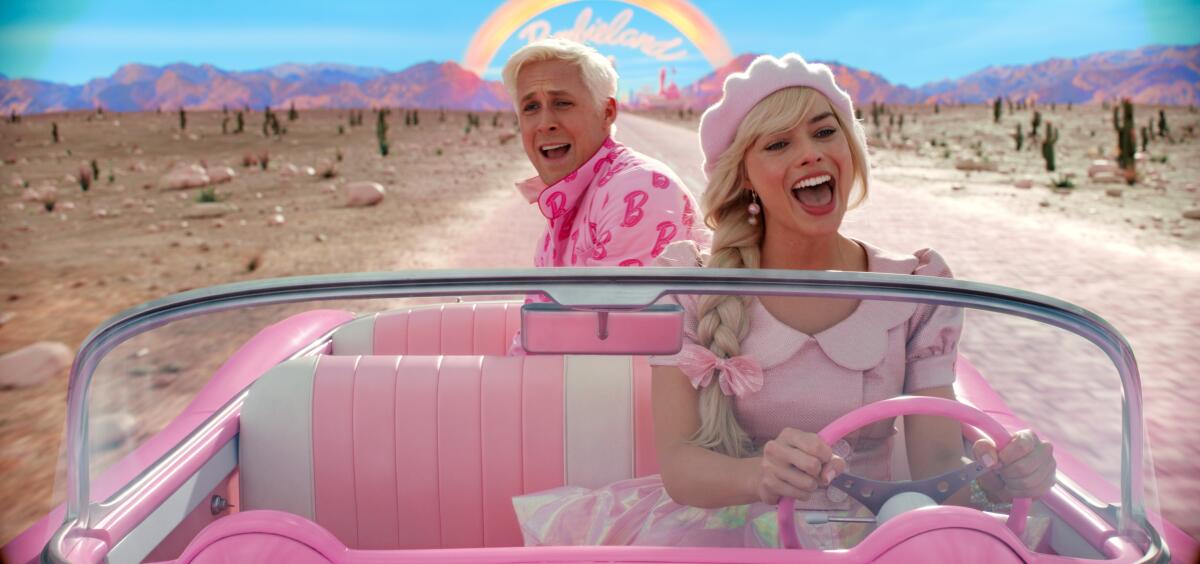UCLA diversity report finds women and minorities drove Hollywood’s biggest successes

- Share via
“Barbie” may have painted the box office pink last year, but the overall picture for women in Hollywood could leave you feeling blue.
Women and people of color drove the biggest box office winners of 2023 even as they continued to remain underrepresented in the film industry, according to the latest UCLA Hollywood Diversity Report released today.
Despite last summer’s “Barbie” juggernaut, women’s representation among screenwriters, lead actors and overall cast dropped in 2023, with the share of women in the directing chair showing virtually no progress from the previous year.
Now in its 11th edition, the UCLA report analyzed the top English-language theatrical releases of 2023 and found that people of color made up the majority of opening-weekend ticket sales for 14 of the top 20 films released last year, while women led ticket buyers for three films in the top 10.
While the box office continued to struggle to return to its pre-pandemic levels overall, audiences flocked to films with diverse casts, the report found.
Nine of the top 10 films globally featured casts that were more than 30% people of color, while five of the top 10 films included casts that were more than 40% women. Movies featuring casts that were 31% to 40% people of color, such as “Barbie” and “The Hunger Games: The Ballad of Songbirds & Snakes,” had the highest median global box office earnings among the top 200 films of the year, at $119.8 million.
Meanwhile, 2023’s franchise installments such as “Creed III,” “Scream VI” and “John Wick: Chapter 4” — all of which featured casts with 50% or more actors of color — posted the highest grosses in their respective series, with audiences of color making up at least 60% of each film’s opening-weekend audience.
“After examining global and domestic box office success and audience demographics for more than a decade, we have repeatedly found that people want to see films that reflect the diversity that exists in their communities and in the world,” said Ana-Christina Ramón, director of UCLA’s Entertainment and Media Research Initiative, in a release accompanying the report.
That trend continued to hold not only domestically but around the world, according to the report. “Diversity sells here and overseas,” said co-author and UCLA doctoral candidate Michael Tran. “It’s the opposite of the conventional myth. The least-diverse films performed the worst and even posted a negative return on the studio’s investment.”

But while women and people of color flexed their muscle at the box office, when it came to representation within the industry itself, the picture was decidedly more mixed.
“Barbie,” directed and co-written by Greta Gerwig, proved a watershed cultural event and smashed box office records, earning $1.4 billion at the global box office, the most for any film ever helmed by a woman. But the film’s message of female empowerment belied a deeper lack of progress for women in the industry.
Only five of the top 200 films were directed by women of color, according to the report, and only three female-directed films had budgets of $100 million or more, compared to 25 male-directed films at that budget level.
The UCLA report’s findings echoed those of a report issued earlier this year by the University of Southern California’s Annenberg Inclusion Initiative that criticized studios’ efforts toward inclusion in hiring in recent years as “performative acts” and “not real steps” toward change.
While people of color remained underrepresented in every major arena of the industry, the report does point to some signs of progress. Representation for lead actors, directors and writers of color saw the largest shares in each of those categories in the study’s 11-year history. The share of theatrical films directed by people of color hit 22.8%, up 6% from the previous year and nearly double the level in 2011. The number of theatrical films with a budget of $100 million or more directed by people of color reached its highest level in the study’s 11-year history.
Still, the authors cautioned that it’s unclear the trajectory will continue. “These gains are most likely a result of the projects greenlit three years ago,” said Darnell Hunt, UCLA’s executive vice chancellor and provost, and co-founder of the report with Ramón. “We’re in a very different and politicized place, and as the efforts and executives who championed inclusivity and equity disappear from studios, will the next three to five years show a freefall in terms of diversity in Hollywood?”
With Hollywood still trying to regain its footing after last year’s devastating strikes among writers and actors, the study’s authors conclude that embracing diversity remains not only a moral imperative but a strategic one for the industry going forward. (The report was financed by UCLA, Netflix, the Golden Globe Foundation, the Latino Film Institute, the Walt Disney Company and Hulu.)
“If Hollywood sacrifices the progress it made on diversity, how will it sustain itself?” the report asks in its conclusion. “Any new version of Hollywood needs to prioritize investing in diversity in front of and behind the camera.”
You can read the entire report here.
More to Read
Only good movies
Get the Indie Focus newsletter, Mark Olsen's weekly guide to the world of cinema.
You may occasionally receive promotional content from the Los Angeles Times.









